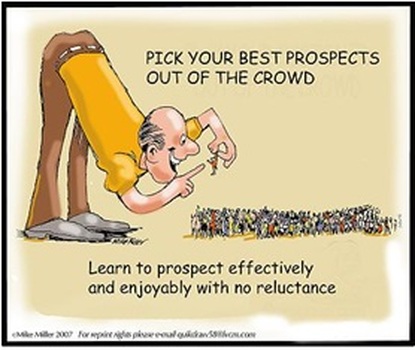Selling When You’re Not a Salesperson
Isn’t it funny how life works? These patterns emerge that we can’t ignore. The same is true in my life. For some reason, I find myself having to market my offerings more diligently while, at the same time, working with clients who need to do the same. So how is it that I and several unconnected clients are grappling with the same issue? My theory is that it is because we teach what we most need to learn.
Ironically, all of the clients I am working with who are challenged to market their business offerings are people who chose a technical career because their passion is technical. By far the majority of them are engineers. This is what they studied and trained for – to build things, or invent things or fix things. All of them are talented and impressive people – so talented and impressive that they have risen through the ranks and now find themselves doing relatively little of what they originally signed up for, and having to build the business. Of course, if they had dreamed of being in marketing and sales, they would have studied for this, wouldn’t they?
Isn’t it funny how life works? These patterns emerge that we can’t ignore. The same is true in my life. For some reason, I find myself having to market my offerings more diligently while, at the same time, working with clients who need to do the same. So how is it that I and several unconnected clients are grappling with the same issue? My theory is that it is because we teach what we most need to learn.
Ironically, all of the clients I am working with who are challenged to market their business offerings are people who chose a technical career because their passion is technical. By far the majority of them are engineers. This is what they studied and trained for – to build things, or invent things or fix things. All of them are talented and impressive people – so talented and impressive that they have risen through the ranks and now find themselves doing relatively little of what they originally signed up for, and having to build the business. Of course, if they had dreamed of being in marketing and sales, they would have studied for this, wouldn’t they?
|
The irony of career progress is that the higher one climbs the ladder, the further one departs from what one’s original chosen career (unless, of course, one ‘s chosen career was business management).
So now that these technical whizz-kids are directors and senior managers of their organisations, it is no longer their technical wizardry that is going to predict their success – it is their ability to bring in new business. And they have absolutely no idea where to start. The purpose of this article is to offer a simple process that can be followed that will enable tech-whizzes to “Just do it”. It does not pretend to be a comprehensive guide but it will give you a starting point. Furthermore, this guide is based on the notion that, at your level, the hard-sell is not appropriate. You are not selling vacuum cleaners. You are selling your organisation. In this context, we use an approach known as “relationship marketing”. You build your business by building relationships. |
|
Step One – Identify Who to Approach In sales-speak, this is called prospecting – you are identifying prospective customers. Your best prospects are like your best current customers in some way, and your best prospective projects will have something in common with your best current and past projects. So look at your current best customers and projects:
So my best current customers are multinational organisations with a regional head office in South Africa. They are mostly in the professional, commercial motor vehicle, manufacturing and construction environment, and they are generally in the top four companies in their market. My best projects provide a minimum of 25 days of work and run over 10 to 12 months – so I am looking for more of the types of customers who fit with those characteristics, and who can and may well commit to the kind of projects I like working on. |
Now you need to do some research and find the organisations that are most like your best current customers, or that commission projects that are most like your best current and past projects. For this, you can conduct internet research, explore industry magazines, journals and newspapers, talk to friends and colleagues – whatever you have to do to find out which companies and specifically which people to make contact with. Create a list – and this must be a list that is a work in progress. Throughout your new career as “Business Development Manager” (which is what you are now, in part, in addition to the balance of your responsibilities) you will be working on this list. Businesses and people will be added and removed based on what you learn, who you meet, who leaves and joins these organisations, etc.
|
Step Two – Make Some Appointments
Pick up the phone and call the person you wish to meet. Just do it. I tell myself this over and over again – because this is the part of the entire selling process that I personally struggle with the most. Tell them who you are, who you work for, and that you would like to come and see them. Perhaps mention what you would like to come and see them about – but do not attempt to sell on the phone!It is fatal. Just get the appointment. And ask for it in a way that makes it really difficult to say “No”. For example, “Hi Robert. This is Fred Smith. I’m the Technical Director from Rainbow Engineering. I’d like to come and see you to talk about your business and see what common ground we might have. I was thinking of Thursday the 8th or Friday the 9th. How are you placed on either of those days?” Once you have the appointment, get off the phone. The longer you stay on this call the more likely it is that you may talk yourself out of the appointment. |
|
Step Three – The Needs Analysis Meeting
The biggest mistake non-salespeople (and many salespeople) make is to assume that they must “sell” in their first meeting with a potential client. You should not initially be there to sell. You are there to learn and establish a relationship. In your first meeting, your purpose is to establish what opportunities there may be to work together. Looking for opportunities to work together feels and is vastly different from “selling”. In order to establish what opportunities there may be, you should be asking a lot of questions – albeit as they relate to your own business. What follows is a simple agenda (with some sample questions) that you could experiment with: |
1. Briefly introduce yourself:
Who are you? What do you do? What are your particular professional interests? What is your purpose in coming to see this
person?
2. Current scenario:
3. Desired scenario
4. Diagnosis
5. Opportunity
6. Request for Proposal
7. The Next Step
Who are you? What do you do? What are your particular professional interests? What is your purpose in coming to see this
person?
2. Current scenario:
- Tell me about your business.
- What are your current challenges? How do you see these challenges being met?
- What is going really well?
- Tell me about your current supplier [of what your own business does].
3. Desired scenario
- Where do you hope to see your business going in the future?
- What are some of the problems/challenges you wish you could solve?
- How would you prefer things to be?
4. Diagnosis
- What do you think is stopping you from getting to where you’d like to be?
- What are some of the causes of your current challenges?
5. Opportunity
- May I tell you about how we might help you with some of your challenges? Now is your chance to tell the prospect
more about what you do and how you might assist him.
6. Request for Proposal
- May I prepare a proposal for how we might help you? Describe what you might include in the proposal and by when
the prospect can expect to receive it.
7. The Next Step
- Even if this first meeting did not result in a request for a proposal, agree on what your follow-up will be. Will you
agree to meet again in a few weeks or months? Is there any other action that you want to take?
Step Four – The Proposal
|
Step Five – Follow-up Meetings and Staying in Touch
Whether or not your needs analysis meeting resulted in a request for a proposal, if this prospect is still the kind of organisation you would like to have as a client, it is important that you keep in contact in some meaningful way. The accepted wisdom is that you should have meaningful contact with your prospects at least once every three months. “Meaningful contact” means:
Make sure that you have a system that helps you to stay in touch. Use reminders in your Microsoft Outlook. Update your prospect list regularly – and have a routine around how often you do it. |
So now you have a place to start. Obviously you need to modify these contents to suit your specifics – but you’re clever people. You must be or you wouldn’t be where you are today! So in the words of a much loved shoe manufacturer – Just Do It!









